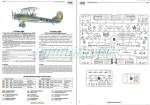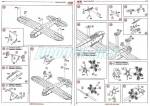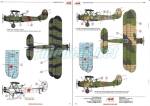
De un vistazo – Quick look
MATERIAL Y PIEZAS
MEDIA & PARTS:
- Plástico trasnaprente (6 pizas), plástico inyectado (103 piezas).
- Clear plastic (6 pieces), injected plastic (103 pieces).
CALCAS – DECALS:
- Insignias rusas y polacas, numerales y eslóganes. Finas y bien saturadas de color.
- Russian and Polish markings, numbers and slogans. Thin with saturated colors.
OPCIONES – OPTIONS:
- Polikarpov U-2VS. Fuerza Aérea Soviética, 213ª División de Bombarderos Nocturnos (NBAD). Verano de 1943.
- Polikarpov U-2VS. Fuerza Aérea Soviética. Invierno de 1942.
- Polikarpov U-2VS. Fuerza Aérea Soviética, 46º Regimiento de Bombarderos Nocturnos de la Guardia (GvNBAP) Tamansky. Primavera de 1945.
- Polikarpov U-2VS. Fuerza Aérea Polaca. 2º Regimiento de Bombarderos Nocturnos (NBAP) “Krakow”. Zona de Lublin, verano de 1944.
- Polikarpov U-2VS. Soviet Air Force, 213rd Night Bomber Air Division (NBAD), Summer 1943.
- Polikarpov U-2VS. Soviet Air Force. Winter, 1942.
- Polikarpov Po-2VS. Soviet Air Force,46th Tamansky Guards Night Bomber Air Regiment (GvNBAP). Spring 1945.
- Polikarpov Po-2VS. Polish Air Force, 2nd Polish Night Bomber Air Regiment (NBAP) “Krakow”. Lublin area, Summer 1944.
INSTRUCCIONES – INSTRUCTIONS:
- Folleto de tamaño A4 con cubiertas en papel satinado a color. Contiene sumario histórico, tabla de colores y equivalencias, plano numerado de piezas, 38 secuencias de construcción, perfiles para arriostrar el modelo y 2 páginas de perfiles a color. Muy claras.
- A4 booklet with satin paper covers printed in color. Contains a historical summary, table of colors with paint matches, numbered parts plan, 38 construction sequences, profiles to rig the model and 2 pages in color with painting choices. Very clear.
LO MEJOR – THE BEST:
- Buen detalle interior y exterior. Opciones de montaje y pintura.
- Very nice exterior and interior detail. Assembly and painting options.
LO PEOR – THE WORST:
- Despiece excesivo en algunas zonas. Piezas delicadas.
- Parts breakdown in some areas. Thin delicate parts.
VALORACIÓN – CONCLUSION:
- Nuevo molde, casi idéntico al último de ICM pero incluye algunas mejoras. Excesivo despiece, pero en conjunto no debe resultar difícil de montar, aunque requiere delicadeza en el proceso. Para aficionados a los biplanos y aviones rusos.
- New tooling with some improvements, but very similar to the last ICM Po-2. Too much parts breakdown, but it doesn’t seem too difficult to build. It needs care in the process. For biplanes and Soviet aviation fans.

Tras unos ocho años, ICM ha decidido dar un paso más con su Po-2 y editar un molde nuevo de esta maqueta. Sin ser mala la anterior edición, que ya dejaba muy atrás el viejo de KP/Kopro en circulación durante décadas, adolecía de pequeños errores tales como un par de marcas en el interior de la carlinga. Aunque este molde es nuevo, ya que la distribución de piezas en los bastidores es totalmente diferente excepto en los transparentes, debe mucho al anterior y hay muchas piezas idénticas, señal de que el fabricante no ha tenido que rehacerlo en su totalidad. Las instrucciones han sido renovadas y las versiones de pintura aumentadas, con lo que también hemos ganado en este aspecto.
La habitual caja de cartón rígido y sobrecubierta a color contiene tres bastidores, uno de ellos transparente, las calcas y las instrucciones. Cuento más de 100 piezas (alternativas incluidas) en total, lo que da una idea del gran despiece para un avión de este tamaño. Sin embargo, nadie debe arredrarse porque el montaje no parece difícil, aunque el modelo hay que trabajarlo con delicadeza por sus piezas pequeñas y finas.
El plástico es el habitual en la marca, con cierta tendencia a blando, bien moldeado y sin restos evidentes de marcas ni material sobrante. Como señalaba antes, el interior de la carlinga ha sido mejorado y ya no viene con las marcas que lo devaluaban en las ediciones anteriores.
El montaje es convencional y sigue en líneas generales el del anterior molde. El fuselaje está dividido en mitades con parte de la estructura interior grabada en fino relieve. Uno de los lados incorpora pequeños instrumentos en piezas aparte. Hay también un panel intermedio entre los dos puestos y paneles de instrumentos en relieve sin calcas para los indicadores. El suelo de la carlinga se ha fabricado sobre el plano inferior de las alas. Sobre él hay que colocar los asientos, bien detallados, los pedales y las palancas de control. Al unir el fuselaje sobre las alas, hay que procurar no dañar los asientos, ya que van pegados a soportes muy finos.
Exteriormente, el fuselaje está provisto de actuadores para la cola y tubos Venturi en piezas separadas. La parte anterior del fuselaje que cubre la bancada del motor viene en dos mitades. El motor es idéntico al del molde previo y está muy bien detallado. Si se trabaja con delicadeza, puede lucir mucho en la maqueta terminada. Consta de una mitad con cilindros más otra mitad sobre esta que muestra los alzaválvulas, una carena frontal opcional, los colectores posteriores y los tubos de escape, muy finos y delicados. La hélice también destaca por su limpieza y buen perfil.
Todos los planos de sustentación me perecen delgados y realistas para la escala, en especial las alas. Supongo que el detalle del entelado se quedará corto para algunos, aunque a mí me parece adecuado. Parece que ICM ha intentado huir de una excesiva regularidad precisamente para lograr verosimilitud. Los planos inferiores están detallados con zonas de pisado, el hueco lateral de observación, cubierto por una pieza transparente, el faro de aterrizaje separado y los patines de las puntas de las alas. Para poder colocar los soportes de las bombas hay que taladrar agujeros en las superficies inferiores, pero están señalados con claridad en las instrucciones. Los soportes parecen tener grosores y perfiles correctos y no parece un reto colocarlos si se consigue alinearlos bien antes de pegarlos definitivamente.
La aleta de cola viene completa en uno de los lados del fuselaje. El timón se puede orientar al venir separado y lleva su correspondiente actuador. Ambos estabilizadores vienen en una sola pieza, con pequeños actuadores en las superficies superiores y soportes finos y quebradizos por abajo. La representación del entelado es similar a la de las alas, acaso con algo más de regularidad.
El tren de aterrizaje es opcional. Hay esquíes para una de las opciones, que ya aparecía en una de las maquetas de la edición anterior. Los esquíes están absurdamente divididos en mitades, pero las ruedas son de una pieza y muestran buen detalle. Los soportes son comunes para ambas versiones y también muestran buena definición, con amortiguadores carenados. Un patín o un pequeño esquí completan el tren de aterrizaje posterior.
El armamento se compone de una ametralladora y bombas. La ShKAS tiene soporte y tambor de munición separados. ICM ha intentado incluso representar las miras del arma, lo que tiene su mérito, ya que son difíciles de reproducir a cualquier escala. Hay cuatro bombas de 50 kg. divididas en mitades con soportes y sujeciones separados. Todo parece muy realista y adecuadamente representado.
El bastidor transparente está embolsado aparte para evitar daños. De él sólo emplearemos dos finos parabrisas y la ventanilla de observación, aunque el bastidor contiene algunas pequeñas piezas más.
El folleto de instrucciones tiene tamaño A4 y sobrecubierta en papel satinado a color. Muestra un sumario histórico sobre el avión, una tabla de colores con equivalencias de pintura de Tamiya y Revell, un plano numerado de piezas, 38 secuencias de ensamblaje, perfiles para arriostrar el modelo y dos páginas de perfiles a color. Las opciones muestran aparatos con camuflajes bicolores y tricolores por arriba y otro en camuflaje invernal. El folleto es mejor y aún más claro que el de la edición anterior, y muestra cambios en el orden de las secuencias de montaje. También incluye más opciones de pintura.
Es una suerte contar con este molde renovado y con más opciones de pintura. La maqueta viene bien detallada y representa con acierto este pequeño bombardero nocturno. La abundancia de piezas no debe ser impedimento porque el montaje aparenta sencillez, aunque también deberá ser cuidadoso por la delicadeza de algunas de ellas. Son de esperar nuevas versiones de este molde con idéntica calidad. Recomendada en especial a los aficionados a los biplanos y la aviación rusa.◊

After some eight years ICM have released a new tooling of their Po-2 kit. Though the previous kits were not bad at all, and they even left the aging KP/Kopro kit far behind, it had some issues such as marks on the cockpit walls. That this is a new tooling can be clearly seen in parts allocations in the sprues, though the clear sprue is exactly the same. Despite the change in the sprues, many parts are the same, a sign that the company was not forced to change everything in the old tooling. Instructions are really new and include more painting versions than before, so in this sense things have also been improved.
The usual sturdy bow with a color covering contains three sprues, one of them with the clear pieces, the decal sheet and the instructions. Parts count is above 100 (including alternative parts) so the breakdown is high for a model of this size. Fortunately, the modeller should not be discouraged, as construction seems quite straightforward. It is also true that the kit needs some finesse to get the most out of it due to some small and brittle parts.
Plastic is the usual stuff in ICM, with a soft touch, well moulded and no flash. As said before, the cockpit has been cleaned from the sink marks it showed in previous releases and that degraded it a bit.
Construction is conventional and follows more or less closely the preceding kits. Fuselage comes in two halves, the cockpit showing a section of the raised internal structure. One of the walls is detailed with a few separate extra bits and there is also a bulkhead in between the stations and two panels with raised instrument and no decal for the gadgets. The cockpit floor is molded on the lower wing and has a couple of nicely detailed seats, the pedals and control sticks. Seats are held by delicate frames, so it is important not to damage them when attaching the fuselage onto the lower wing.
Externally, the fuselage is provided with separate actuators for the tail and Venturi tubes. The fuselage front is also a separate section comprising two halves. The engine is the same good rendition as in previous kits. If carefully worked, it must enhance the finished model. The main components are a row of cylinders coupled with a front row of tappers, an optional casing, the rear manifold and a couple of very thin and brittle exhausts. The propeller is also good with correct size and shape.
I think both wings and tailplanes are quite thin and look realistic, especially the wings. I suppose surface detail will not be good enough for some, but for me it is quite nice. It seems ICM has tried to convey the tapered surfaces with some irregularity to make them more convincing. The lower wing shows the no-step areas, a hollow section to place the clear part for the observation window, the landing light and the tip skids. To install the bomb racks holes must be drilled on the bottom surfaces, but fortunately the instructions are very clear about this. Interplane struts look fine with seemingly correct thickness and shapes. They do not seem an issue to attach if correctly aligned before gluing them definitely.
The tailfin comes moulded on one of the fuselage sides. The rudder is a separate part with an actuator apart. Tailplanes are just one piece with actuators on the upper surfaces and very thin and delicate struts on the bottom. The rendering of tapered surfaces is similar to that on the wings, but perhaps a bit more regular in definition.
Landing gear is optional. There are a couple of skis for one of the options that was also present in one of the preceding kits. Skis are unfortunately moulded in halves, but the wheels are really nice and show good detail. Struts are common for both versions, showing fine faired shock-absorbers. The tail gear is also optional, comprising either a skid or a small ski.
Armament comprises a machine-gun and bombs. The ShKAS looks nice and is provided with a separate mount and ammo box. ICM have also tried to depict the gun crosshair, a nice try that it is difficult to achieve at any scale. There are four 50kg. bombs moulded in halves and separate rackets and brackets. Everything looks quite realistic and appropiately represented.
The clear sprue comes inside a separate self-sealing bag to protect the parts. We will only use two very thin windshields and the observation window on the lower wing, though there are a few other parts on the sprue.
The instruction A4 booklet has two satin pages printed in color. It shows a historical summary about the Po-2, a numbered parts plan, a table of colors with matches in Revell and Tamiya paints, 38 constructions sequences, profiles to rig the model and two final pages in color with the painting options. These show aircraft in different summer camo schemes and one in a winter scheme. The booklet is even better than in the previous releases and has many changes in the assembly sequence and more painting choices.
We are lucky to have an improved tooling of the Po-2 back in the market. The kit is very well detailed and is a nice rendition of this small night bomber. Parts breakdown should not hinder the interested modeller as construction seems quite direct, but some care is also needed during assembly. Recommended to biplane and Russian aviation fans.◊
Actualizado – Updated: 4 / 2022
Publicado – Published: 8 / 2020
©www.jmodels.net















Debe estar conectado para enviar un comentario.